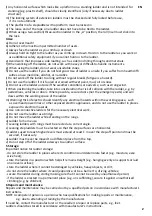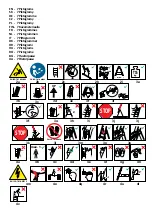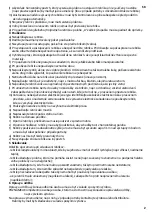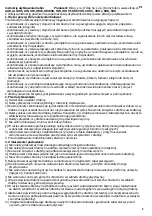
2
EN
l) Any horizontal surface which looks like a platform on a standing ladder and is not intended for
standing (e.g. plastic shelf), should be clearly identified. (only if necessary due to ladder
structure).
m) The locking system of extension ladders must be checked and fully locked before use,
if it is not automatic.
n) The platform of a stepladder with a platform must be locked in.
o) The loose end of the rope on a ladder does not have to be tied to the ladder.
p) When using a two-section/three-section ladder in the „A“ position, the roll/riser must click into
the lock.
4 Use
a) Do not overrreach!
b) Adhere to the maximum permitted number of users.
c) Always face the ladder as you climb up or down.
d) Always hold on tight to the ladder as you climb up or down. Hold on to the ladder as you work or
use additional safety equipment if you cannot hold on to the ladder.
e) Avoid work that imposes a side loading, such as side/on drilling through solid materials.
f) When working off the ladder, do not work with heavy or difficult-to-handle instruments.
g) When using the ladder, do not wear unsuitable shoes.
h) Do not use the ladder if you do not feel good. Use of ladder is unsafe if you suffer from health diffi
culties or use medicine, alcohol, or narcotics.
i) Do not work off the ladder too long without regular breaks (fatigue is a hazard).
j) Do not use the ladder if it is fouled or stained with wet paint, mud, oil or snow.
k) Do not use the ladder outside if the weather conditions are adverse, such as strong wind.
l) When positioning the ladder, take into consideration the risk of collision with the ladder, e.g. by
pedestrians, vehicles or doors. Where possible, secure doors (not the emergency exits) and win
dows within the working space of the ladder.
m) Warning! Risk of electric shock! Identify any electrical hazards within the working space, such
as overhead power lines or other exposed electric appliances, and do not use the ladder in places
exposed to electrical hazards.
n) Use non-conductive ladders for the necessary electrical work.
o) Do not use the ladder as a bridge.
p) Do not move the ladder while standing on the rungs.
q) Ladder for home use.
r) Leaning ladders with rungs must be erected at a correct angle.
s) Leaning step ladders must be erected so that the step surfaces are horizontal.
t) Ladders used to reach higher levels must extend at least 1 m over the step-off point and must be
secured, if necessary.
u) Ladder must never be moved to a different place from the top.
v) Do not step off of the ladder sideways to another surface.
5 Storage
Important notice for ladder storage:
- do not store the ladder in places where its condition could deteriorate faster (e.g. moisture, exce
ssive heat);
- store the ladder in a position which helps it remain straight (e.g. hanging evenly on supports or laid
on an even surface);
- store the ladder where it cannot be damaged by vehicles, heavy objects, or dirt;
- do not store the ladder where it could jeopardize, or be a barrier to, driving vehicles;
- secure the ladder during storing making sure that it cannot be used by unauthorised person;
- if the ladder is erected in a permanent place (e.g. on scaffolding), secure it against unauthorised
climbing (e.g. by children);
6 Repairs and maintenance
Repairs and maintenance may be carried out by a qualified person in accordance with manufacturer‘s
instructions.
NOTE A competent person is a person who has qualifications for making repairs or maintenance,
e.g. due to attending a training by the manufacturer.
If need be, contact the manufacturer or the reseller to repair or replace parts, e.g. feet.
Ladders should be stored in accordance with manufacturer‘s instructions.


















